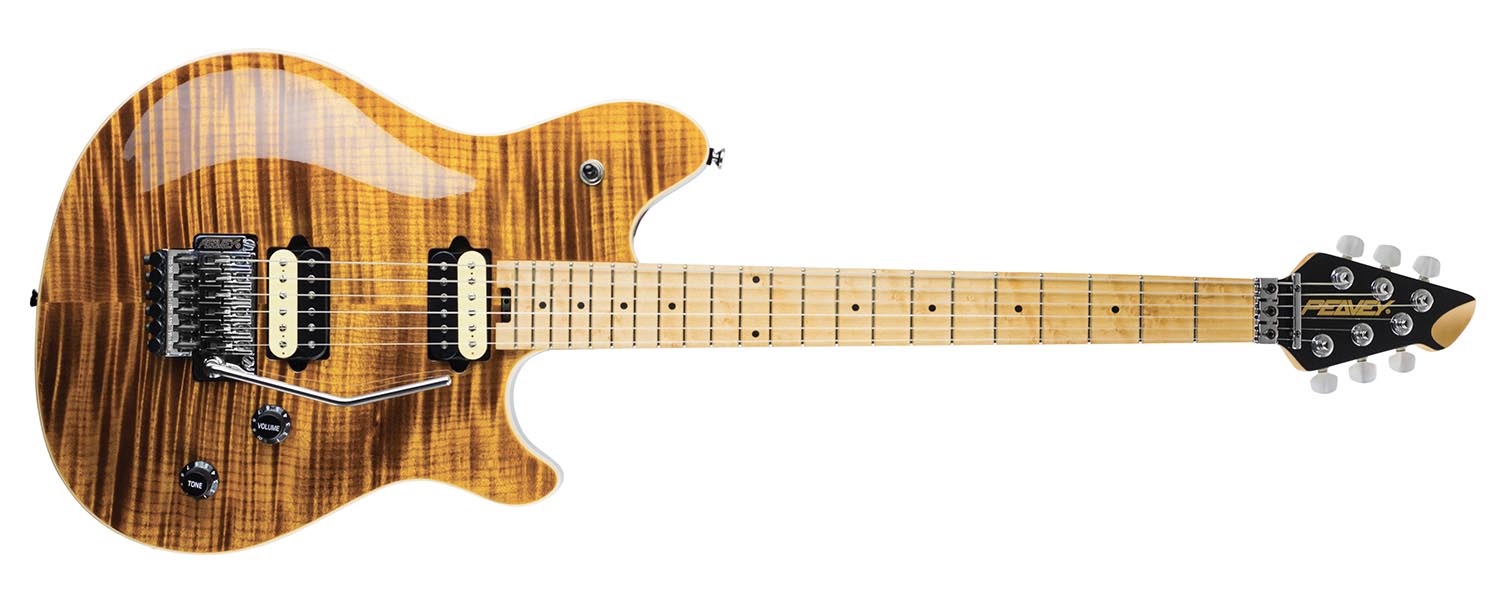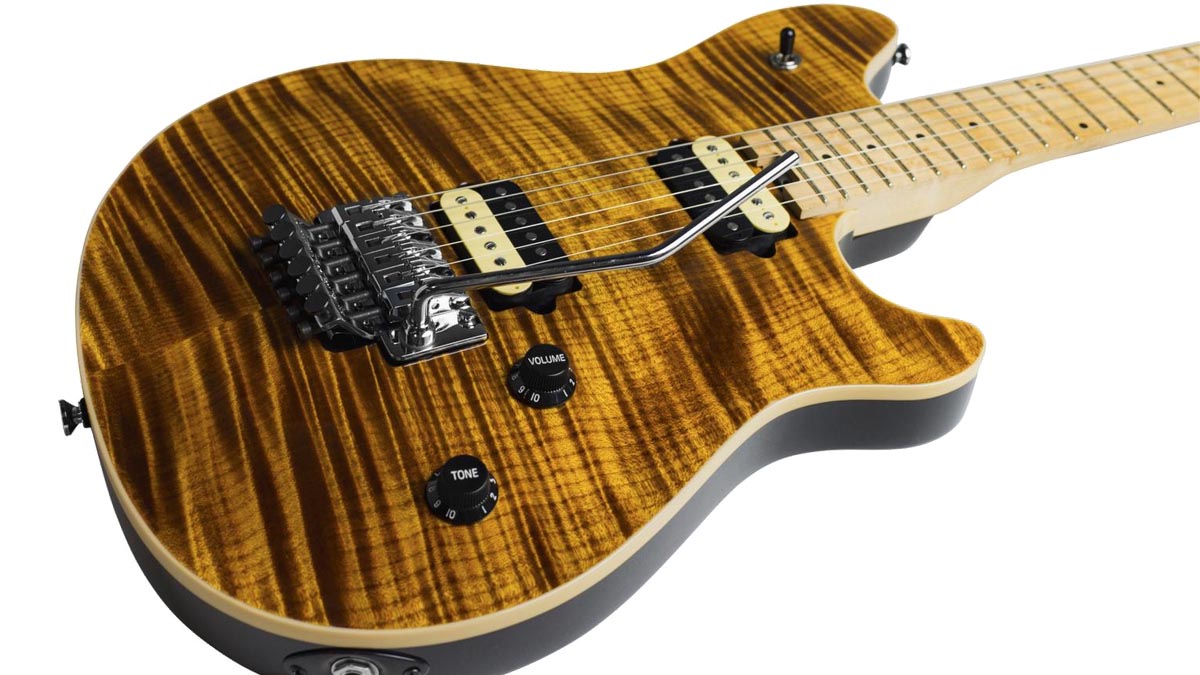Guitar World Verdict
After a hiatus, the Peavey HP 2 is back and as good as it ever was, with expressive high-gain pickups, a comfortable, highly playable design and first-class construction and materials.
Pros
- +
It's a tone machine that excels with high-gain or clean amps.
- +
Tigereye top is exquisite.
- +
Great whammy setup.
- +
Playability.
- +
Credible single-coil tones.
Cons
- -
Can difficult to engage the coil-split setting.
You can trust Guitar World
The Original Peavey Wolfgang model, developed by and for Eddie Van Halen in 1995 and discontinued in 2004 when Ed left Peavey to start his own EVH brand, was one of the Mississippi company’s biggest successes.
That success continued when the model immediately re-emerged afterwards as the HP 2, with HP paying tribute to the company’s founder Hartley Peavey.
After a brief hiatus from the market, Peavey resurrected the HP 2 in 2017 only to run into production challenges at its USA factory in 2019. In late 2020 the company announced that production resumed, but now the HP 2 was being built in Europe. Demand for the model has been so high that it took us nearly two years to get one for review, but rest assured it was worth the wait.
Features

The specs of the new HP 2 remain consistent with the original iteration, including a generously thick, carved, figured maple top over a basswood back and select single-piece birdseye maple neck and slab fingerboard.
The neck is bolted to the body at a sculpted neck heel with no neck plate, and its specs include a 25 ½-inch scale, 15-inch radius, 22 medium frets, 1 5/8-inch nut width, truss rod adjustment wheel inset above the 22nd fret and oil finish.
The maple top on our Tigereye example had exquisite flame figuring, tastefully complemented by single-layer cream binding, while the basswood back was finished in black.
The electronics consist of Peavey-designed zebra-coil high-output humbuckers (the measured resistances on our example were 15.07k Ohms bridge/12.84k Ohms neck) that are mounted directly to the body, master volume and master tone controls each with push/pull switches to engage coil tapping for the pickups individually, and a Switchcraft three-way pickup selector toggle switch (bridge/both/middle) and ¼-inch side-mounted output jack.
Hardware includes a Peavey-licensed chrome-plated Floyd Rose double-locking tremolo, a six-string retainer bar on the headstock and Schaller mini-tuners with pearloid buttons.
Performance
It only takes a few seconds of playing the HP 2 to realize why so many players are still huge, dedicated fans of this model. Playability is top-notch, with the new factory paying the same meticulous attention to detail that results in a very comfortable feel and exquisite playability, with the fretwork being particularly noteworthy.
The neck feels exceptionally solid and stable, and the oil finish provides a just-right balance between rock-steady resistance and smoothness to facilitate runs up and down the neck.
The HP 2 sounds like a beast when played through an amp adjusted to high-gain distortion, but it sounds equally impressive when played with clean settings
The humbuckers are expertly dialed in to deliver outstanding tone with highly detailed definition, expressive midrange, crispy upper harmonics and robust bass that is tight, punchy and percussive.
The HP 2 sounds like a beast when played through a guitar amp adjusted to high-gain distortion, but it sounds equally impressive when played with clean settings, delivering full-bodied tone with an alluring treble sparkle.

With the coil-split settings engaged, the pickups produce genuine single-coil tones with attractive spank and twang, with the neck pickup sounding like a Strat and the bridge pickup resembling a Tele. My only beef is that the skirted top-hat knobs can make it difficult to engage the coil-split setting.
There are a few notable differences between the HP 2 and the original Wolfgang. The Floyd Rose bridge does not feature a D-Tuna, and it is also set up in a floating configuration with a body cavity that allows players to pull the bar up, instead of being mounted flush to the body.
For many players the latter is a bonus, as it enables hummingbird flutter tricks, pedal steel licks and other whammy shenanigans.
Specs
- PRICE: $2,499 / £2,599 (case included)
- TYPE: Solid-body electric guitar
- BODY: Basswood with flame maple top
- NECK: Birdseye maple, bolted on, graphite reinforced and oil-finished
- FINGERBOARD: Birdseye maple, 15" radius
- FRETS: 22
- SCALE: 25.5"
- ELECTRICS: 2 Peavey Designed direct-mount humbuckers, volume, tone w/coil-split, three-way Switchcraft pickup selector
- HARDWARE: Schaller locking tuners, Peavey licensed Floyd Rose
- CONTACT: Peavey
Chris is the co-author of Eruption - Conversations with Eddie Van Halen. He is a 40-year music industry veteran who started at Boardwalk Entertainment (Joan Jett, Night Ranger) and Roland US before becoming a guitar journalist in 1991. He has interviewed more than 600 artists, written more than 1,400 product reviews and contributed to Jeff Beck’s Beck 01: Hot Rods and Rock & Roll and Eric Clapton’s Six String Stories.
“It holds its own purely as a playable guitar. It’s really cool for the traveling musician – you can bring it on a flight and it fits beneath the seat”: Why Steve Stevens put his name to a foldable guitar
“Finely tuned instruments with effortless playability and one of the best vibratos there is”: PRS Standard 24 Satin and S2 Standard 24 Satin review












